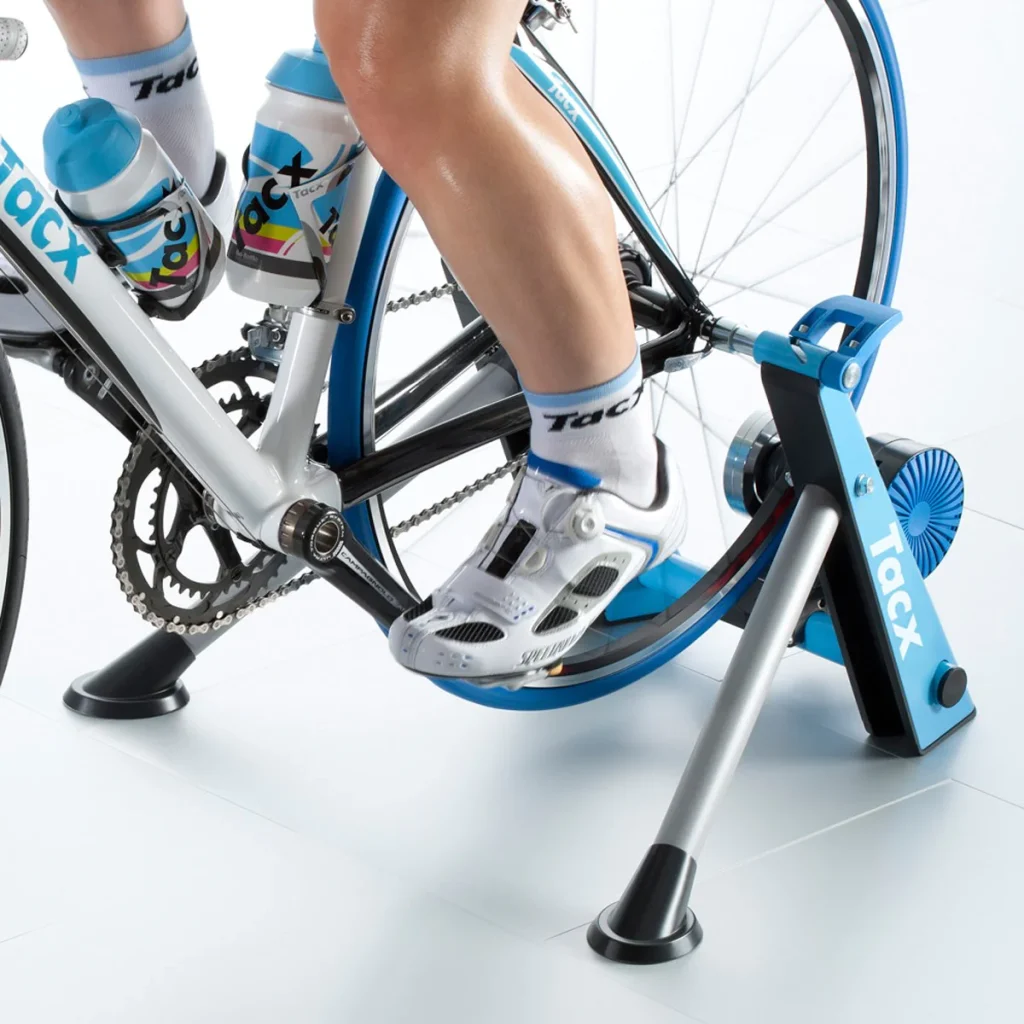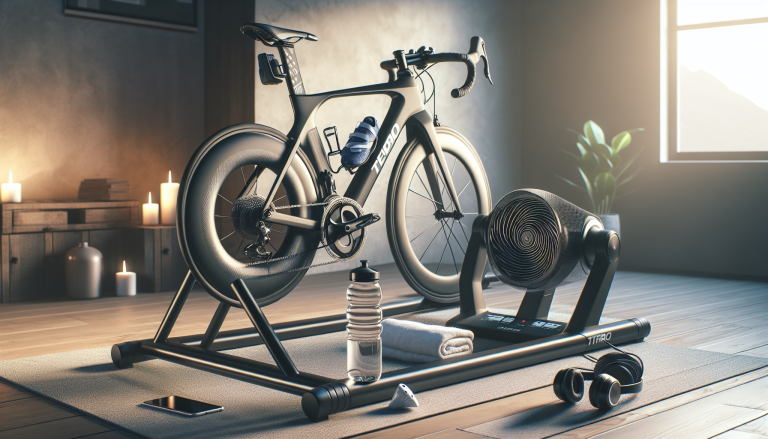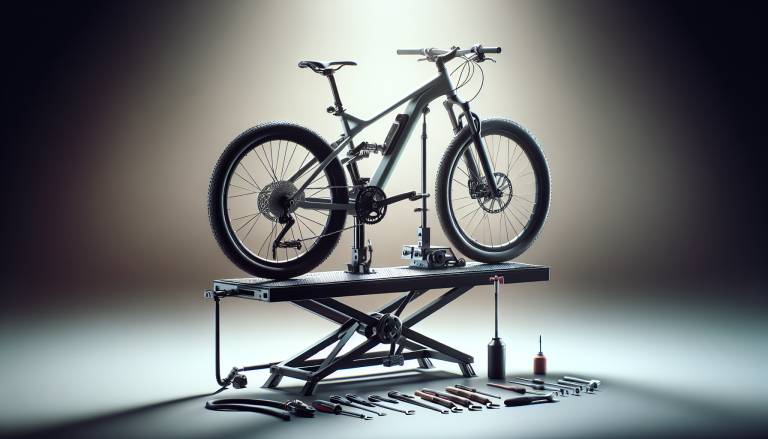Are you a cyclist looking to take your training to the next level? Look no further than our comprehensive Guide to Turbo Training for Cyclists. Whether you’re a beginner or an experienced rider, this guide will provide you with the ultimate training regimen to improve your performance on the bike. With a variety of workouts designed to target different aspects of cycling, from endurance to sprinting, you’ll be able to maximize your training time and see significant results. From setting up your turbo trainer correctly to tracking your progress, this guide covers it all. Get ready to pedal your way to success with our Guide to Turbo Training for Cyclists.
Table of Contents
ToggleChoosing the Right Turbo Trainer
When it comes to choosing the right turbo trainer, there are a few factors to consider. The first step is to familiarize yourself with the different types of turbo trainers available:
Types of Turbo Trainers
- Wheel-on Trainers: These trainers have a roller that presses against the rear wheel of your bike. They are relatively affordable and easy to set up, making them a popular option for beginners.
- Direct Drive Trainers: With direct drive trainers, you remove the rear wheel of your bike and attach the trainer directly to the frame. These trainers offer a more realistic road feel and greater accuracy in power measurement.
- Smart Trainers: Smart trainers can connect to various training apps and software, allowing you to simulate virtual rides and access training programs. They often come with built-in power meters and can automatically adjust the resistance based on the virtual route or workout you choose.
Considerations for Choosing a Turbo Trainer
When selecting a turbo trainer, consider your specific needs and goals. If you’re on a budget and want a basic setup, a wheel-on trainer may be sufficient. However, if you’re serious about indoor training and want a more immersive experience, a direct drive or smart trainer may be worth the investment.
Other factors to consider include noise level, stability, and compatibility with your bike. Be sure to check if the trainer supports the type of bike you have, whether it’s a road bike, mountain bike, or a bike with thru-axle. Also, keep in mind that different trainers offer different maximum resistance levels, so choose one that suits your fitness level and training requirements.
Budget Considerations
Turbo trainers come in a wide price range, from budget-friendly options to premium models. It’s important to set a budget and stick to it, but also remember that investing in a quality trainer can enhance your training experience and provide long-term benefits. Consider the features that are most important to you and find a balance between affordability and functionality. It’s also worth checking for any discounts or promotions that may be available.
Setting Up Your Turbo Trainer
Once you have chosen the right turbo trainer, it’s time to set it up for your indoor training sessions. Follow these steps to ensure a smooth and effective setup:
Choosing a Suitable Location
Find a suitable location in your home where you can set up your turbo trainer. Ideally, this should be a well-ventilated area with enough space around you to move comfortably. Consider placing a trainer mat underneath your setup to protect your floor from sweat and provide added stability.
Preparing Your Bike
Before mounting your bike onto the turbo trainer, make a few adjustments to ensure a secure and comfortable fit. Check your tire pressure and inflate it to the appropriate level recommended by the trainer manufacturer. Additionally, ensure that your bike’s drivetrain is clean and properly lubricated for optimal performance.
Adjusting the Turbo Trainer
Each turbo trainer comes with different adjustments that allow you to align it with your bike’s geometry and ensure a smooth and stable ride. Follow the instructions provided by the manufacturer to adjust the trainer’s roller position, resistance settings, and any additional features it may have. Take your time to fine-tune these settings to match your preferences and training goals.
Essential Equipment for Turbo Training
To make your turbo training sessions more comfortable and effective, there are several essential pieces of equipment you might consider investing in:
Trainer Mat
A trainer mat placed under your turbo trainer can protect your floor from damage and reduce noise and vibrations. It also provides a stable surface, ensuring that your setup remains secure during intense workouts.
Front Wheel Block
A front wheel block raises the front wheel of your bike, creating a level riding position. This helps to simulate the natural riding position and improves stability and comfort during your indoor training sessions.
Sweat Guard
A sweat guard is a protective cover that prevents sweat from dripping onto your bike’s frame and components. It helps to prolong the lifespan of your bike and reduces the need for frequent cleaning and maintenance.
Fan
During intense indoor workouts, you’re likely to work up a sweat. Using a fan helps to keep you cool and comfortable by circulating air and preventing overheating. It can enhance your performance and make your training sessions more enjoyable.
Heart Rate Monitor
A heart rate monitor is a valuable tool for tracking your effort and monitoring your cardiovascular fitness. It provides real-time feedback on your heart rate, allowing you to train in specific heart rate zones and optimize your workouts.
Cadence Sensor
A cadence sensor measures the number of pedal revolutions per minute. It helps you maintain a consistent and efficient pedaling technique, allowing you to train at different cadence targets and improve your overall cycling performance.
Entertainment Setup
To make your turbo training sessions more engaging and enjoyable, consider setting up an entertainment system. This could include a television, tablet, or smartphone connected to training apps or streaming services. Listening to music, watching videos, or joining virtual group rides can help alleviate boredom and add fun to your indoor rides.
Effective Warm-Up and Cool-Down Routines
Before diving into a turbo training session and after completing one, it’s crucial to incorporate warm-up and cool-down routines into your workout. These routines prepare your body for exercise and aid in recovery:
The Importance of Warm-Up and Cool-Down
A proper warm-up prepares your muscles and cardiovascular system for the upcoming workout. It increases blood flow, raises body temperature, and improves flexibility, reducing the risk of injury. On the other hand, a cool-down routine helps to gradually bring your heart rate and body temperature back to normal, promotes recovery, and prevents post-exercise muscle stiffness.
Sample Warm-Up Routine
- Start with 5-10 minutes of easy pedaling at a low resistance.
- Gradually increase the resistance and target a comfortable cadence.
- Incorporate short bursts of higher intensity efforts (around 20-30 seconds) to wake up your muscles.
- Finish with 5 minutes of easy pedaling, allowing your heart rate to slowly come down.
Sample Cool-Down Routine
- Gradually reduce the resistance and maintain a comfortable cadence for 5-10 minutes.
- Include some gentle stretching exercises to promote flexibility and relax your muscles.
- Focus on deep breathing and allow your body to gradually recover.
Structured Training Plans for Turbo Training
To maximize the benefits of turbo training, it’s important to follow a structured training plan that targets specific fitness goals. Here’s what you need to know about creating an effective training plan:
Understanding the Different Types of Training Zones
Training zones are used to categorize different intensities of exercise based on heart rate or power output. These zones provide a framework for structuring workouts and allow you to train at different levels of effort. The commonly used training zones include endurance, tempo, threshold, VO2 max, and anaerobic zones.
Creating a Training Plan
When creating a training plan, identify your specific goals, such as improving endurance, increasing power, or preparing for a race. Assess your current fitness level and then determine the appropriate training volume and intensity. Consider incorporating a variety of workouts, including interval training, endurance rides, and strength training sessions, to target different aspects of your fitness.
Progression and Periodization
To avoid plateaus and ensure continued improvement, it’s essential to incorporate progression and periodization into your training plan. Gradually increase the volume, intensity, or duration of your workouts over time while allowing for adequate recovery periods. Periodization involves dividing your training plan into distinct phases, such as base training, build phase, and peak phase, each with specific objectives and focus.
Monitoring and Adjusting Your Training Plan
Regularly monitor your progress by tracking key metrics such as heart rate, power output, and training load. This will help you assess your performance and identify areas for improvement. Be flexible and open to adjusting your training plan as necessary based on your responses to training and external factors such as fatigue, illness, or unforeseen circumstances.
Interval Training for Turbo Training
Interval training is a highly effective method of turbo training that involves alternating between periods of high-intensity effort and periods of active recovery. This type of workout helps to improve aerobic and anaerobic fitness, increase speed and power, and enhance overall endurance. Here’s an overview of interval training for turbo training:
Introduction to Interval Training
Interval training involves working at an intensity close to your maximum effort for a specific interval, followed by a period of recovery or lower intensity effort. This cycle is repeated multiple times during a workout, challenging your body to adapt and improve.
Types of Interval Training Workouts
There are several types of interval training workouts you can incorporate into your turbo training routine:
- Tabata Intervals: Named after the Japanese scientist who developed the method, Tabata intervals involve 20 seconds of all-out effort followed by 10 seconds of rest. This pattern is repeated for multiple cycles.
- Pyramid Intervals: Pyramid intervals gradually increase in intensity before reaching a peak and then decrease again. For example, you may start with 30 seconds of high intensity, followed by 30 seconds of recovery, then increase to 1 minute of high intensity, and so on, before working back down.
- Threshold Intervals: Threshold intervals aim to improve your lactate threshold, which is the point at which lactic acid starts to accumulate in your muscles. These intervals involve sustained efforts slightly below your lactate threshold for several minutes, followed by short recovery periods.
Sample Interval Training Workouts
Here are a few sample interval training workouts to get you started:
- Tabata Intervals: Warm up for 10 minutes, then perform 8 cycles of 20 seconds all-out effort, followed by 10 seconds of rest. Finish with a 5-minute cool-down.
- Pyramid Intervals: Warm up for 10 minutes, then start with 30 seconds at a high intensity, followed by 30 seconds of recovery. Increase the high-intensity interval duration by 15 seconds each cycle until reaching 1 minute, then work back down. Finish with a 5-minute cool-down.
- Threshold Intervals: Warm up for 10 minutes, then work at slightly below your lactate threshold for 6 minutes, followed by 2 minutes of recovery. Repeat this cycle 4-6 times, depending on your fitness level. Finish with a 10-minute cool-down.
Remember to tailor the intervals to your fitness level and gradually progress over time to continue challenging yourself.
Strength and Power Training for Turbo Training
Strength training is a valuable component of turbo training that can enhance your power output, improve muscular endurance, and reduce the risk of injury. Here’s what you need to know about incorporating strength training into your turbo training routine:
Benefits of Strength Training
Strength training offers numerous benefits for cyclists. It helps to improve overall muscular strength and power, which translates into increased speed and efficiency on the bike. It also helps to prevent muscle imbalances, enhance bone density, and reduce the risk of overuse injuries.
Incorporating Strength Training into Your Turbo Training
To incorporate strength training into your turbo training routine, aim for two to three sessions per week. Focus on exercises that target the major muscle groups used in cycling, such as the legs (quadriceps, hamstrings, and calves), core, and upper body. Examples of strength training exercises that can be performed at home include squats, lunges, deadlifts, planks, push-ups, and seated rows.
Sample Strength Training Exercises
Here are a few sample strength training exercises to get you started:
- Squats: Stand with your feet shoulder-width apart, lower your hips down as if sitting back into a chair, and then return to a standing position. Repeat for 10-12 reps.
- Lunges: Take a step forward with one leg, bending both knees until your front thigh is parallel to the ground and your back knee is close to the floor. Return to the starting position and repeat with the other leg. Aim for 10-12 reps per leg.
- Planks: Assume a push-up position, but with your forearms on the ground. Hold this position for 30 seconds to 1 minute, focusing on maintaining a straight line from your head to your heels.
- Seated Rows: Attach resistance bands or use dumbbells if available. Sit in an upright position with your legs extended in front of you. Pull the bands or weights towards your chest, squeezing your shoulder blades together. Perform 10-12 reps.
Remember to focus on proper form and start with a weight or resistance level that allows you to perform each exercise with good technique. Gradually increase the resistance or repetitions as your strength improves.
Endurance Training for Turbo Training
Endurance training is an essential component of turbo training that helps to build the aerobic base, increase stamina, and improve overall fitness. Here’s what you need to know about incorporating endurance training into your turbo training routine:
Importance of Endurance Training
Endurance training focuses on long, sustained efforts and helps to improve your body’s ability to efficiently utilize oxygen, increase energy production, and enhance muscular endurance. It forms the foundation of your fitness and allows you to ride longer and maintain a steady pace for extended periods.
Long Steady Distance (LSD) Rides
Long steady distance (LSD) rides are the cornerstone of endurance training. These rides involve maintaining a steady pace at a low to moderate intensity for an extended duration, typically ranging from 2 to 4 hours or more, depending on your fitness level and goals. LSD rides help to build endurance, improve fat metabolism, and enhance the cardiovascular system.
Sample Endurance Training Rides
Here are a few examples of endurance training rides you can include in your turbo training routine:
- Base Endurance Ride: Warm up for 10 minutes, then maintain a comfortable pace at about 65-75% of your maximum heart rate or power output for 2 hours. Focus on maintaining a smooth and steady cadence.
- Tempo Endurance Ride: Warm up for 10 minutes, then alternate between 15 minutes at a tempo intensity (75-85% of your maximum heart rate or power output) and 5 minutes of recovery for a total of 2 hours.
- Progressive Endurance Ride: Warm up for 10 minutes, then gradually increase the intensity throughout the ride. Start at a low to moderate intensity for the first hour, then progressively increase to a moderate to high intensity for the second hour. Finish with a 10-minute cool-down.
Remember to hydrate properly and refuel with carbohydrates during longer endurance rides to maintain energy levels. Listen to your body and adjust the duration and intensity as needed to accommodate your fitness level and recovery capabilities.
Recovery and Rest Days
Recovery and rest days play a vital role in turbo training as they allow your body to adapt, repair, and recharge. Here’s what you need to know about incorporating recovery and rest days into your training routine:
Understanding the Importance of Recovery
Recovery is the period when your body rebuilds damaged tissues, replenishes energy stores, and adapts to the stress of training. It’s during this time that fitness gains occur, allowing you to become stronger and more resilient. Without proper recovery, you may experience decreased performance, increased fatigue, and an increased risk of overtraining and injury.
Active Recovery vs. Rest Days
When planning your training week, aim to include both active recovery and complete rest days. Active recovery involves low-intensity activities, such as gentle cycling, stretching, or yoga. These activities promote blood flow, aid in the removal of metabolic waste, and help optimize your recovery.
Rest days, on the other hand, involve total physical and mental rest. This means avoiding all forms of structured exercise and allowing yourself time for relaxation and rejuvenation. Rest days are essential for replenishing energy stores, reducing mental and physical fatigue, and preventing burnout.
Activities for Active Recovery
Here are a few examples of activities you can include in your active recovery days:
- Gentle spinning on the turbo trainer at a low resistance
- Yoga or stretching exercises to improve flexibility and promote relaxation
- Low-impact activities like swimming or walking
- Foam rolling or self-massage to alleviate muscle soreness and tightness
Remember to keep the intensity low and listen to your body. Active recovery should leave you feeling refreshed and rejuvenated, not fatigued.
Tips for Effective Rest Days
To make the most of your rest days, consider the following tips:
- Stay Hydrated: Even on rest days, it’s important to drink plenty of water to support optimal recovery and overall health.
- Get Quality Sleep: Sleep is a crucial component of recovery. Aim for 7-9 hours of quality sleep each night to allow your body to repair and recharge.
- Practice Stress Management: Rest days are an excellent opportunity to engage in activities that help you relax and reduce stress. Consider mindfulness meditation, deep breathing exercises, or engaging in hobbies you enjoy.
- Pay Attention to Nutrition: Proper nutrition is essential for recovery. Focus on consuming a balanced diet rich in whole foods, including plenty of fruits, vegetables, lean proteins, and healthy fats. Consider including sources of omega-3 fatty acids, such as fatty fish or flaxseeds, which have anti-inflammatory properties.
By incorporating regular recovery and rest days into your turbo training routine, you’ll set yourself up for continued progress and long-term success.
Mental Strategies for Turbo Training
Staying motivated and mentally engaged during turbo training can sometimes be a challenge. Here are some helpful mental strategies to make your indoor training sessions more enjoyable and rewarding:
Maintaining Motivation
- Set SMART Goals: Setting specific, measurable, achievable, relevant, and time-bound (SMART) goals gives you something to work towards and helps you maintain motivation and focus. Whether it’s completing a certain number of training sessions per week, achieving a specific power output, or participating in a virtual race, having goals can keep you motivated.
- Reward Yourself: Treat yourself to small rewards after completing challenging workouts or reaching milestones. It could be anything from enjoying a favorite snack to indulging in a relaxing bath or rewarding yourself with new cycling gear.
- Join Virtual Group Rides or Challenges: Participating in virtual group rides or challenges can provide a sense of community and support. It allows you to connect with other cyclists, share experiences, and motivate each other to push harder.
Coping with Boredom
- Create a Playlist: Put together a motivational playlist of your favorite music or podcasts to keep you entertained and motivated during your training sessions. Music can help distract from the monotony and make the time go by faster.
- Watch TV Shows or Movies: If you have a television or tablet setup near your turbo trainer, consider watching TV shows or movies to pass the time. Choose engaging content that can capture your attention and make training more enjoyable.
- Try Virtual Reality Riding: Virtual reality training apps or online platforms can provide a more immersive experience by simulating real-world rides in stunning virtual environments. This can add excitement and make your workout feel more interactive and engaging.
Setting and Achieving Goals
- Break Down Your Goals: Break down larger goals into smaller, more manageable milestones. This will make your progress feel more tangible and help build confidence and motivation along the way.
- Track Your Progress: Use a training diary or an app to keep track of your workouts, progress, and achievements. Seeing your improvement over time can be incredibly motivating and provide a sense of accomplishment.
- Celebrate Successes: When you achieve a goal or milestone, take the time to celebrate and acknowledge your hard work. Celebrating achievements boosts motivation and reinforces positive behaviors.
Visualization Techniques
- Visualize Success: Before a challenging workout, spend a few moments visualizing yourself successfully completing it. See yourself pushing through the tough moments, maintaining good form, and achieving your desired outcome. Visualizing success can help boost confidence and mental preparedness.
- Create a Mental Focus: During your turbo training sessions, choose a mental focus point such as maintaining a smooth pedaling technique or engaging your core. By having a mental task to focus on, you can distract your mind from any discomfort or fatigue.
- Practice Mindfulness: Pay attention to the present moment, focusing on your breathing, sensations, and thoughts without judgment. Mindfulness can help you stay grounded, reduce stress, and enhance your overall training experience.
By implementing these mental strategies, you can stay motivated, combat boredom, and make the most of your turbo training sessions.
In conclusion, turbo training is an excellent way for cyclists to maintain and improve their fitness when outdoor riding is limited or not feasible. By choosing the right turbo trainer, setting up your equipment correctly, following a structured training plan, and incorporating effective warm-up, cool-down, and recovery routines, you’ll be well on your way to achieving your cycling goals. Stay motivated, stay consistent, and enjoy the benefits of turbo training. Happy cycling!







